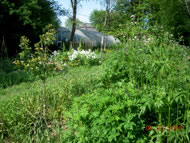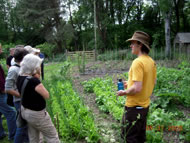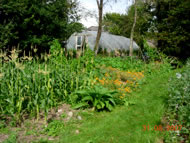UK
FOREST GARDENING
Regenerating landscapes, rediscovering abundance.
SCHUMACHER COLLEGE near Totnes in South Devon has been a pioneering college of holistic education for over twenty years. Students leave the college nourished by the high quality of the educational experience, which includes helping to prepare and cook the food for staff and participants.
Over the past two years Schumacher has further deepened this aspect of the learning process by actively engaging with the land and rediscovering true abundance in its woodland ecosystems.
Inspired and informed by its neighbours at the Agroforestry Research Trust, Schumacher College has been regenerating its grounds using a dynamic ‘layering’ design known as forest gardening. Tree crops, shrub crops and perennial herbaceous plants grown in harmony with each other produce an abundance of seasonal foodstuffs whilst contributing to the health and integrity of the land.
Designed with diversity in mind, these ‘foodscapes’ seek to embody the natural principles of a healthy temperate woodland: this is the pattern of least effort and maximum diversity. Growing food in tune with this woodland tendency requires less effort, less machinery, and less fossil fuel – and the result is an almost unbelievable abundance.
Schumacher staff and participants have now planted over 100 fruit and nut trees to form the canopy layer of the woodland gardens. Peaches and apricots are grown as espaliers against sunny south-facing walls. Apple, pear and plum trees dot the landscape as do less common crops such as Cornelian cherries, hardy kiwifruits and Ugni berries. Sweet chestnut, walnut, hazel and bladdernut are also carefully positioned.
The greenhouse serves as a nursery to propagate edible under-storey plants from seed. Also nestled within the forest gardens are a series of ‘no-till’ vegetable beds. While the focus is on perennial crops, it is not at the expense of the obvious pleasures that come from fresh vegetables.
Because the gardens are designed to be self-sustaining, plants that are not necessarily directly useful have been carefully integrated as well. These include nitrogen-fixing trees and shrubs to improve the soil fertility, as well as mineral accumulators such as comfrey, sorrel and valerian. The gardens also provide a feast for the bees with a careful selection of nectar- and pollen-laden flowering plants.
Using a technique called sheet mulching – covering over the grass with a thick, light-impenetrable layer of material such as old carpet or newspaper – areas of lawn are being replaced. A year later the soil is rested, full of the nutrients from the decomposed grass and ready to be planted with a wide mix of edible herbaceous plants.
Just two years on from the main planting, the diet of Schumacher residents is benefiting immensely. The salad bowl, for example, has included more than 200 different edible species throughout the course of the year. However, the students and staff at Schumacher College find that the learning experience is itself the highest-yielding crop in the garden. By actively participating in and encouraging the tendencies of the land, they are more fully enabled to see past some of the most basic assumptions about the separation of humans from Nature.










